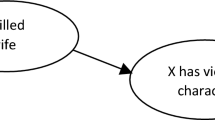Abstract
Disputes over causes play a central role in legal argumentation and liability attribution. Legal approaches to causation often struggle to capture cause-in-fact in complex situations, e.g. overdetermination, preemption, omission. In this paper, we first assess three current theories of causation (but-for, NESS, ‘actual causation’) to illustrate their strengths and weaknesses in capturing cause-in-fact. Secondly, we introduce a semi-formal framework for modelling causal arguments through strict and defeasible rules. Thirdly, the framework is applied to the Althen vaccine injury case. And lastly, we discuss the need for new criteria based on a common causal argumentation framework and propose ideas on how to integrate the current theories of causation to assess the strength of causal arguments, while also acknowledging the tension between evidence-based and policy-based causal analysis in law.



Similar content being viewed by others
Notes
Different versions of the framework have been presented at the Evidence and Decision Making Workshop, ICAIL, 2017, London and AICOL Workshop, JURIX, 2017. This paper presents the latest developments of the framework to date.
At the initial stages of the case study, we annotated the decision identifying causal and accompanying hedging expressions. After identifying the main causal links in the case, we ranked the various expressions in two levels of strength. For instance, ‘a probable causal relation between tetanus toxoid and two injuries’, ‘it is more probably than not the case that tetanus toxoid can cause the injuries suffered here’ are examples of level 2 (usually causal) support.
References
Althen v Secretary of HHS (2003) The court of federal claims, Golkiewicz, Chief Special Master, 2003 WL 21439669
Beebee H, Hitchcock C, Menzies P (2009) The Oxford handbook of causation. Oxford University Press, Oxford
Bex F, Walton D (2012) Burdens and standards of proof for inference to the best explanation: three case studies. Law Probab Risk 11(2–3):113–133
Bex F, Van Koppen P, Prakken H, Verheij B (2010) A hybrid formal theory of arguments, stories and criminal evidence. Artif Intell Law 18(2):123–152
Bochman A, Lifschitz V (2015) Pearl’s causality in a logical setting. In: AAAI, pp 1446–1452
Chockler H, Fenton N, Keppens K, Lagnado D (2015) Causal analysis for attributing responsibility in legal cases. In: Proceedings of the 15th international conference on artificial intelligence and law. ACM, pp 33–42
Dymitruk M, Markovich R, Liepiņa R, El Ghosh M, van Doesburg R, Governatori G, Verheij B (2018) Research in progress: report on the ICAIL 2017 doctoral consortium. Artif Intell Law 26(1):49–97
Giunchiglia E, Lee J, Lifschitz V, McCain N, Turner H (2004) Nonmonotonic causal theories. Artif Intell 153(1–2):49–104
Halpern JY (2016) Actual causality. MIT Press, Cambridge
Halpern JY, Hitchcock C (2010) Actual causation and the art of modeling. In: Dechter R, Geffner H, Halpern J (eds) Heuristics, probability, and causality: a tribute to Judea Pearl. College Publications, London, pp 383–406
Hart HLA, Honoré T (1985) Causation in the law. Oxford University Press, Oxford
Honoré T (2010) Causation in the law. In: Zalta EN (ed) The Stanford encyclopedia of philosophy. Winter 2010 edition, 2010
Kowalski R, Sergot M (1989) A logic-based calculus of events. Foundations of knowledge base management. Springer, Berlin, pp 23–55
Lehmann J, Gangemi A (2007) An ontology of physical causation as a basis for assessing causation in fact and attributing legal responsibility. Artif Intell Law 15(3):301
Lehmann J, Breuker J, Brouwer B (2004) Causation in AI and law. Artif Intell Law 12(4):279–315
Modgil S, Prakken H (2014) The ASPIC+ framework for structured argumentation: a tutorial. Argum Comput 5(10):31–62
Moore M (2009) Causation and responsibility: an essay in law, morals, and metaphysics. Oxford University Press, Oxford
Mueller E (2014) Commonsense reasoning: an event calculus based approach. Morgan Kaufmann, Los Altos
Pearl J, Mackenzie D (2018) The book of why: the new science of cause and effect. Basic Books, New York
Posner RA (2010) How judges think. Harvard University Press, Cambridge
Prakken H (1993) A logical framework for modelling legal argument. In: Proceedings of the 4th international conference on artificial intelligence and law. ACM, pp 1–9
Prakken H, Sartor G (2009) A logical analysis of burdens of proof. In: Kaptein H, Prakken H, Verheij B (eds) Legal evidence and proof: statistics, stories, logic. Ashgate, Aldershot
Research Laboratory for Law, Logic & Technology, Vaccine Injury Project. http://www.lltlab.org/projects/data-projects/vaccineinjury-project/. Accessed 01 Sep 2018
Schaffer J (2016) The metaphysics of causation. In: Zalta EN (ed) The Stanford encyclopedia of philosophy. Fall 2016 edition, 2016
Turner H (1999) A logic of universal causation. Artif Intell 113(1–2):87–123
Walker V, Vazirova K, Sanford C (2014) Annotating patterns of reasoning about medical theories of causation in vaccine cases: toward a type system for arguments. In: ArgMining@ ACL, pp 1–10
Walton D (2005) Argumentation methods for artificial intelligence in law. Springer, Berlin
Wright RW (2011) The NESS account of natural causation: a response to criticisms. In: Goldberg R (ed) Perspectives on causation, vol 285. Hart Publishing, Oxford, p 305
Author information
Authors and Affiliations
Corresponding author
Additional information
Publisher's Note
Springer Nature remains neutral with regard to jurisdictional claims in published maps and institutional affiliations.
Rights and permissions
About this article
Cite this article
Liepiņa, R., Sartor, G. & Wyner, A. Arguing about causes in law: a semi-formal framework for causal arguments. Artif Intell Law 28, 69–89 (2020). https://doi.org/10.1007/s10506-019-09246-z
Published:
Issue Date:
DOI: https://doi.org/10.1007/s10506-019-09246-z




